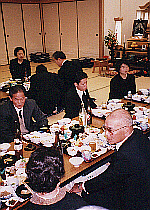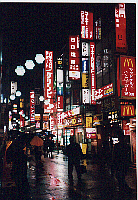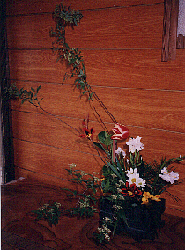Buddhist sutra books were distributed to those paying their respects. The bo-san rang
the gong/bell and led us in a monotonic reading of a sutra wishing peace for Ojii-san's
spirit. An incense box was passed around and we each added a pinch of incense to that which
was already burning. Reading the sutra was like a high-speed kanji flash card test --
column after column of Chinese characters with no conjugating kana. And if that wasn't
enough to make one's head spin, there were one's feet to consider.
As chonan (first son) of the chonan of the deceased, I was in the first
row and had to hold my kneeling position through the whole sutra -- no fidgeting allowed!
I started to lose feeling in my feet at around the 15-minute mark, and they were completely
numb by the time the sutra ended (24 minutes, 30 seconds -- I was counting!).
Then the bo-san, who has studied comparative religion, explained the ceremony and put it
into context with other faiths. He may have thought he was doing us a favour by inviting us
to sit raku style (crosslegged) while he spoke, but it meant another five minutes of exquisite agony
as my nerve endings fired off erratically in celebration of the blood returning to my toes.
I did my best to keep a straight face!

|
Afterwards we moved to the other side of the room and had a delicious lunch with our guests.
The design of the legs of the collapsible tables was ingenious! See how they
allow for traditional Japanese use (kneeling height) or Western use (sitting height).
|

|
Ososhiki Links
The late Juzo Itami's film
Osoushiki (The Funeral)
(Review 1 |
Review 2)
An easy (and funny) way to learn about Japanese funerals
A Traditional Japanese Burial
Suite 101's "End of the Road in Buddhist Japan"
Japanese Funerals
The Japanese Way of Death: A Funeral in Sapporo
An excellent account by David Aldwinckle
Japan: Trying to Observe Traditional Burial Rites
About Japanese Weddings and Funerals
Choice of Exits: People Opt for Nontraditional Funerals, Graves
Reikyusha: Japanese hearse
Money Talks
My father and my aunts and uncles used the rest of the afternoon to discuss how to split
Ojii-san's estate. He had written his will in the traditional Japanese way,
leaving almost everything to my father, his eldest son. My aunts, however, had devoted a great deal of time to
caring for Ojii-san in his final years.
|
Most of the Japanese men who emigrated in the earlier
part of this century were second, third, fourth, etc. sons. They probably knew they weren't
going to inherit anything if they stuck around, so they went abroad to find their fortunes!
|
In-laws and children were not included in this discussion, so Emi-chan,
Michiko Oba-san from Kyoto and I went to to keep Obaa-san company.
Obaa-san was back in the hospital after having had a transient medical complication.
In doing so, she lost her spot at the seniors centre. Although she was better now, she couldn't
be discharged until the next seniors centre vacancy came up
(Canadians are quite familiar with this health care scenario!).
Sachiko Oba-san came to get us at suppertime. They weren't finished talking yet, but wanted
to take a break. We all went to a sushi restaurant and had a nice meal.
I got to taste
wasabi-zuke --
tsukemono (pickled condiments) made of
wasabi (horseradish) stems.
The taste was similar to
but weaker than the prepared wasabi you get with sushi (that green paste), which is made of
the ground root of the plant. Instead of clearing your sinuses, the tsukemono just tingles your tongue.
Toshinobu Oji-san and Takeo Oji-san, both of whom work at Japanese universities,
bemoaned the low literacy levels of their students these days --
they sounded like Canadian profs! Nobody once mentioned the will. After supper, we left the restaurant and
split into two groups, one going back into Ojii-san's house to talk, and one heading for the hospital.
|
One of the Great Lakes First Nations
(the Iroquis? correct me) apparently
has a decision-making system that incorporates the elements of sequestered discussion in a
longhouse until a consensus is reached. Meals during the discussion period are strictly social.
These similarities are interesting, given the postulated path of human migration to North America.
|
We helped Obaa-san look for Japanese folk tale characters in the patterns of the ceiling
tiles in her room, until she fell asleep. Then we tried to stay awake until someone came from
the house (well after midnight) to tell us they had decided stop talking for the day and would
continue in the morning. They eventually did reach a decision, just in time for everyone to
catch their planes, boats, hydrofoils and trains home.
 Bladerunner Night - Japanese Dystopia
Bladerunner Night - Japanese Dystopia
Rain and neon greeted my late evening arrival in Fukuoka. In the train station,
homeless people were meticulously constructing
shelters out of clean (of course) cardboard.
They were absorbed in their task, and none of them asked for money.
At my hotel, the management left warnings in the rooms about the consequences of
using the premises for Telephone Club
(
enjo kosai - "compensated dating", a euphemism for "teenage prostitution").
And to think I had thought that those girls in the lobby dressed in high school uniforms were
in town on a school trip! Late night Japanese TV was strange as usual,
except that on the ubiquitous talk show panels, the spots of the once-fashionable
Japanese-speaking gaijin were occupied by now-hip Japanese transvestites.
The Dark Side of Japan
Rori-kon (Lolita Complex) and enjo kosai
Homeless People in Tokyo
Antonio Who?
When I got to Tokyo to visit my mother's side of the family, Obaa-san
interrupted our customary chat to tune into the television broadcast of
Antonio Inoki's
final match from the Tokyo Dome.
Many celebrities
from his past had come to Japan to watch.
I had no idea that Obaa-san was a puroresu (PURO RESUringu = pro wrestling) fan,
any more than I knew who Inoki is! After an Internet search, I found
his daughter's homepage.
 Heijitsu ryokou (weekday trip) to Ito
Heijitsu ryokou (weekday trip) to Ito
Obaa-san, Yoneko Oba-san,
my cousin Taku and I piled into their car and headed down the freeway for a trip to
Ito,
a half-day drive from Tokyo. It was a weekday, so we were able to make good time,
slowing down only for the inevitable and frequent toll booths. The traffic was mainly
commercial, and there were many moving vans (see box below).
Japanese highwayside rest stops are much like those in North America, except for free
ocha (green tea) and mugicha (barley tea)
and the obligatory omiage (gift) shop featuring regional food specialties.
Everywhere the sakura (cherry) trees were in full bloom (mankai),
visible as exuberant puffs of pinkish-white scattered across the hillsides.
It seemed that at least 1/4 of the trees in Japan are cherry trees!
|
Early April is the busiest time of the year for Japanese companies. Their fresh university graduates
must be welcomed, oriented and trained, and existing workers are given promotions, transfers or new assignments.
Men's clothing stores have "Recruit Special" suit sales. Often one of a new recruit's first tasks is to
camp overnight under a cherry tree to reserve a spot for the company's
hana-mi (cherry blossom viewing) outing!
|
Hot Soaks
One of the unique pleasures of a trip to Japan is a visit to a
Japanese hot spring (onsen).
For many Japanese it is the focal point of their vacations. We went to several
onsen
around the resort town of Ito, on the
Izu peninsula.
At one, there was a blood pressure machine and a weigh scale in the changing room.
Taku's blood pressure was 10 mmHg higher than mine -- perhaps because of the stress of being
a sarariman? We are the same height, but Taku is 5 kg lighter -- he says (jokingly)
that he's aspiring to be a "modern Japanese male" by purposely not building up muscle and
instead cultivating his mind.
|
San K (Three K's) was a popular term many years back
referring to jobs that the Japanese find undesirable: kitsui (demanding),
kitanai (dirty) and kiken (dangerous). These days the Japanese use
imported workers from places like Iran and Sri Lanka for manual labour.
|
Izakaya Intro
Back in Tokyo, I spent the evening in Kichijoji, in the western part of the city.
Shopped out and feeling peckish, I stepped into an izakaya (small tavern)
near the train station.
I had never been in a real izakaya before, but this one was just as I had pictured
from friends' accounts and seeing movies. It was a cosy, low-ceilinged room with subdued but warm lighting.
Small groups of sararimen and OLs (ofisu reyidiizu - office ladies) sat
in friendly conversation at small tables along the walls. There was a shelf with all
of the personal whiskey and sake bottles of the regular customers, their names written on the front.
I sat at the sushi bar in the centre of the room.
A maguro (tuna) special was on that night - the fish could be prepared any of
six different ways, none of which I had heard of before. I was experiencing menu paralysis
- too many choices! The North American picture of Japanese food is more detailed
than it was twenty years ago, when there was only teppan-yaki, but it is still far from complete.
I would have liked to have stayed all night and sampled everything, but it was time to go home.
|
Seasonal foods are important in Japanese cuisine, representing a tie with nature
(e.g. bamboo shoots in the spring, chestnuts in the fall). Bamboo shoots (take no ko) can be the size of a small goose.
Just like a Peking duck, the shoot's many layers and parts have varying textures and tastes and are used in different dishes!
Bamboo shoot harvesting
|
Going or Coming?
From the commuter train I saw the window of a second-storey ballroom dance studio, just like in the recent film
Shall We Dansu (Dance)?
Unlike Kohji Yakusho's character I stayed on the train, though. Looking around the car at my fellow riders,
I could see the familiar faces of Japanese Canadians I've worked with in the Toronto community
over the past year -- Julie, Mark, Lori, David, Laura, Noreen, Wayne, Mia, Karri, Jennifer
-- except these people on the train could speak Japanese!
I boarded the plane for Canada this time knowing I would be returning to Japan in August for
hatsu-bon, the first Festival of the Dead after Ojii-san's
death. I used to think that my ties with Japan would weaken once my grandparents died.
Instead, they seem to be growing stronger!
[Back to TOP]
View my guestbook |
Sign my guestbook
 visitors since 22 June 1998
visitors since 22 June 1998
[ HOME ]
[Travel Index]







 Bladerunner Night - Japanese Dystopia
Bladerunner Night - Japanese Dystopia
 Heijitsu ryokou (weekday trip) to Ito
Heijitsu ryokou (weekday trip) to Ito
 visitors since 22 June 1998
visitors since 22 June 1998